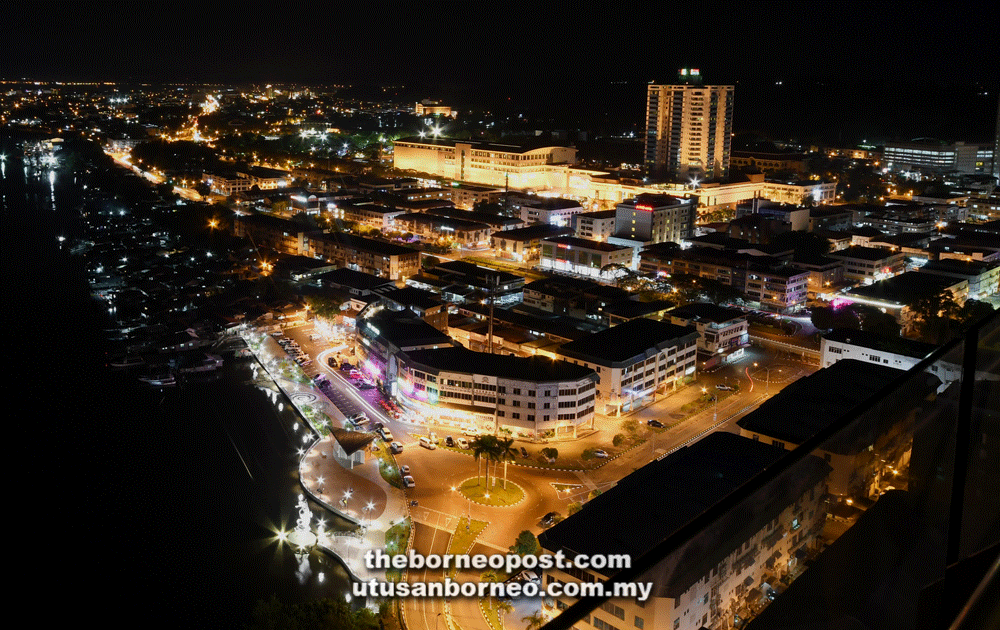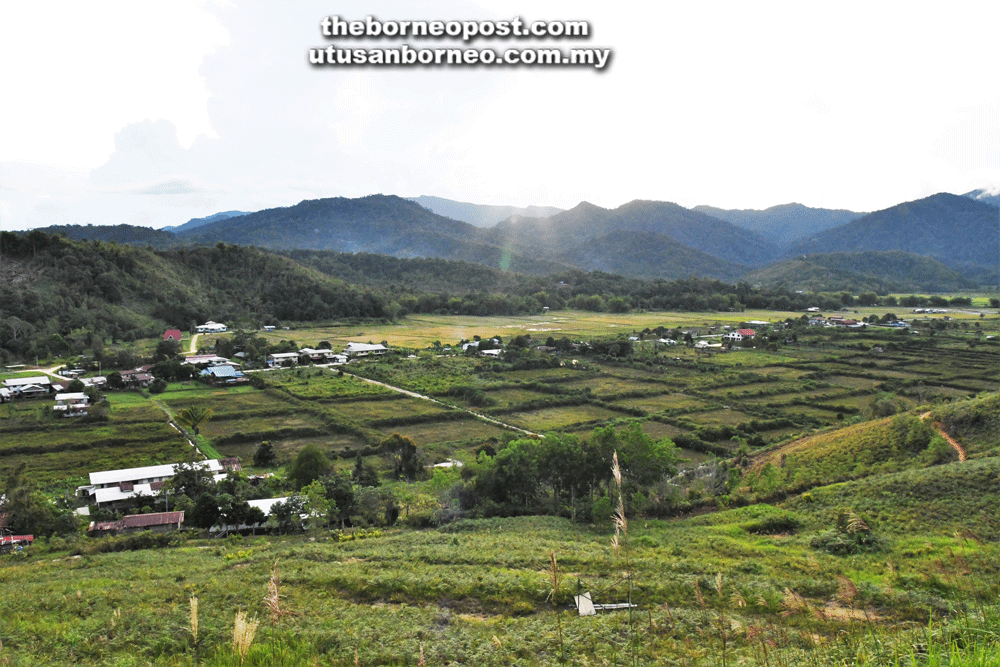
A night view of Miri.
IN 2014, Miri City Council (MCC) launched its five-year corporate vision to make Miri the most liveable resort city.
Part of the plan involved three strategic thrusts – clean and green, vibrant and safe as well as community and culture.
This year should have been MCC’s fifth year of implementing the vision but there hasn’t been much notable headway since the idea took shape.
Sarawak Tourism Board (STB) chief executive officer Sharzede Datu Salleh Askor spoke to thesundaypost recently on the challenges faced in pursuing the vision and what could be done to grow Miri to its full potential as a tourism destination and Sarawak’s resort city.

Sharzede (seated centre) with the STB team during the unveiling of angpow designs for Chinese New Year.
Sharing her first impression of Miri, Sharzede said it was, undeniably, a gem with a lot of potential.
“Since I joined STB in September last year, I have been here three to four times. Miri strikes me as a very clean city. The whole ambience of life there is more laid back and relaxed.
“There should be something and somewhere for everyone – locals, tourists, and travellers – to do or go to. Miri already has many attractions but a bit more is needed to facilitate a fully enjoyable experience and add vibrancy to the place.”
According to her, Miri is home to interesting cultures, cuisine, and some trademark festivals and events, as well as nature and adventure attractions.
As the northern gateway of Sarawak, Miri has much to offer such as the Bario Highlands, the Mulu and Niah Caves, and the lovely beaches, to name a few.

A view of Niah Cave.
Masterplan
A masterplan to develop Miri into tourism destination is crucial as Sharzede believes suitable infrastructural facilities and amenities are essential to a resort city lifestyle. Some of the things worth considering are more food courts or eateries, more entertainment programmes, and more festivals and events.
Sharing her visit to Tusan Beach last month, Sharzede said a plan was in place to develop it. She lauded the initiative as a step in the right direction to attract tourists.
“When tourists go to the beach, they expect beach activities such as paragliding, diving and snorkelling. The expectations are there, the natural attractions are there as well. What we need now are the facilities to tie the experiences together.”
On the attractions of the Highlands and Mulu National Park, she said, “These should be promoted and packaged in such a way that meets the expectations of those who have never been there before. Make it as interesting as possible for them.
“The branding should highlight the uniqueness that makes Miri stand out against other places.”

Sunset viewed from Miri Waterfront Jetty.
Miri’s signature
Every destination needs a signature – a landmark like the KLCC Twin Towers, historical heritage like Melaka, or iconic events such as the Songkran Water Festival in Thailand – through which an attraction or product is instantly recognised as synonymous with the destination.
Miri has been known as an oil and gas town which, in itself, has a rich history but to switch from this identity to that of a resort city will take a lot of work.
Sharzede cited the Borneo Jazz Festival (BJF) as potentially a part of Miri’s internationally recognised musical, cultural and festive identity, similar to what Rainforest World Music Festival (RWMF) is to Kuching.
“I always believe tourism is what the community should take pride and part in, particularly the events being organised, because there’re always economic spin-offs in any tourism activity. Hence, with an iconic event like BJF, locals should be supportive and proud of it.”
The three-day Borneo Jazz Festival is into its 14th edition this year and Sharzede has revealed STB is taking a different approach to promote and package the event.
“Innovation is necessary to make BJF an iconic event on par with RWMF. The latter started more than 21 years ago, playing, as I understand, to only a small audience of a few hundred people back then.
“But it has grown out of sight to attract more than 22,000 followers and fans now. RMWF took 22 years to achieve this. By comparison, BJF is still young with, I believe, a lot of room for improvement,” she said.
Sharzede added that scheduling BJF just a week after RWMF to make July the Festival Month was part of the plan.
“We’ll have a RWMF fringe festival to be followed by the main event (July 12-14) and BJF one week later (July 19-21).
“We want to package July as the Festival Month so that people who go to RWMF will probably take time to enjoy Miri and its popular spots and then head to BJF.
“We hope the number of tourists coming will be more than last year. In 2018, international attendees made up about 25 per cent of the total audience. We have a positive feeling about this.”

Miri has a laid-back ambience.
Promotions underway
She revealed promotions of BJF had already started Berlin, Germany, among several foreign countries, and interviews for both RWMF and BJF had also been carried out.
“We’ve started pushing the promotions and building up the interest and anticipation among music fans and curious people. The response and demand have been good so far,” she said, adding that BJF was targeting an audience of about 4,000.
Besides promoting BJF as a musical event, Sharzede also wants it viewed from the angle of building music tourism in Sarawak.
“This could lead to the unveiling of a lot of talents among young Sarawakians – plus ample opportunities for them as well.”
RWMF and BJF have encouraged a melding of traditional and contemporary performing arts among the youths of Sarawak, leading to a renaissance of cultural music.
Both festivals are also prioritising recycling with RWMF, in particular, focusing on reducing the carbon footprint and waste generation by restricting the use of non-biodegradable cutlery and plates during the festivals – apart from recycling and composting all waste products and using shuttle buses to and from the festival venue to cut carbon emissions from cars.

The green environment of Bario.
Niche markets
Viewed from the bigger picture, Sharzede felt Sarawak should be seen as a prime destination for niche tourism markets.
“It may have its limitations in terms of facilities and connectivity, yet some see it as uniquely interesting, both economically and culturally, compared to the peninsula.”
According to her, Sarawak’s uniqueness lies in its rich cultures from over 27 ethnic groups, 40 sub-category ethnic groups, the beautiful natural products and the food, among others. And maintaining the authenticity of these assets is one way for Sarawak to position itself and stand out among other parts of the world.
Sharzede stressed since travellers and tourists could be divided into different types of market segments, it was important to understand their needs.
“Sarawak may be the choice of one group but not another group. Hence, providing excellent tourism-related infrastructures, facilities and services is of utmost importance.
“We’ve both hardware and software, so we need all stakeholders, especially product owners, to really polish their gems to make Sarawak the preferred destination.
“The Tourism Ministry and STB will also endeavour to make the ecosystem in the tourism sector right for the industry to grow further.
“Exploring the natural environment and getting a feel of the daily routines of the locals can be a different experience for travellers, yet, at the end of the day, those willing to pay more for their hotels can also expect top-grade service in return.
“Therefore, I believe offering international standard service is the way to keep the tourists coming.”
She said although talks on tourism generally referred to either mass market or niche market, having proper infrastructures was paramount, regardless.
“If we’re looking at niche tourism, which I feel is the right direction for Sarawak and Miri, we should be focusing on and working towards high yield while trying to achieve a balance along the way.
“If we want to boost tourism in Miri, we should first develop the infrastructures and the products in tandem with efforts to position the city as a high yield destination.”

A band performance at last year’s BJF.
Creating a brand
Sharzede opined that creating the Sarawak brand would ultimately be the cumulative results of expectation and experience.
“In promoting Sarawak, we market what the state has to offer. The onus is on the product owners and service providers to offer the experience to match or exceed what the visitors anticipate.
“The ‘dream come true’ satisfaction turns first-time visitors into return visitors – and the stories they tell are powerful marketing tools.
“In this regard, we rely heavily on our stakeholders and product owners. They are the ones who give visitors the Sarawak — in this instant Miri – experience. This, in turn, will help to indelibly etch our branding in the visitors’ minds.”
She pointed out that for Miri or Sarawak as a whole, tourists, especially from the state’s closest – and more traditional – markets such as neighbouring Brunei, Indonesia, Singapore and even Sabah, were the greatest assets.
Sharzede strongly believes niche tourism is the way to go for Sarawak, saying it allowed locals to enjoy the fruits of the development of the tourism industry.
She added that focusing on niche tourism also discouraged over-tourism which would eventually become mass tourism.
“In such a case, locals will feel the pinch when the costs of living are beyond them to meet the demands of tourists. Moreover, the product can become over commercialised.
“The downside is that this will cause the product to lose its authenticity and originality – which leads me to conclude that to boost tourism, we need to be bold but, at the same time, keep it niche-based so that the product can develop and offer both locals and foreign visitors alike the same enjoyment. Such balance will sustain the product for a long time.”
Sharzede said the involvement of industry players was crucial in that all stakeholders needed showcase and package the product before selling it to potential customers.
She also underscored the benefits industry players in Miri could derive through a consortium-like relationship, noting that a pricing equilibrium could be found to ensure fair play in the tourism industry.
“Investing in tourism is an on-going effort since tourism is one of the biggest contributions to the country’s GDP,” she added.
